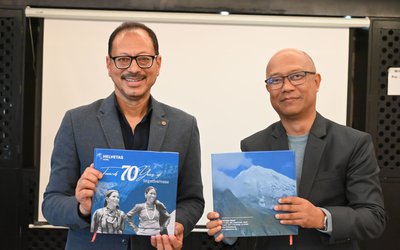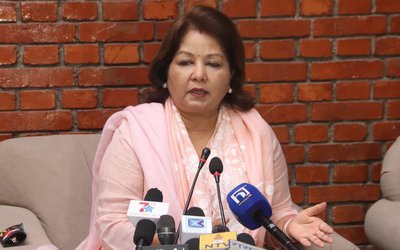At a time when the pressure is building to hold the elections for local bodies from various sectors, a report of Rapid Governance Assessment conducted by Media Initiative for Right, Equity and Social Transformation (MIREST-Nepal), a civil society organization, reveals that elections are the only way out to fill the political vacuum that exists in the local bodies
Bimala Gautam, secretary of Naikap Village Development Committee of Kathmandu district, took Rs. 15,000.00 (160 US dollars) as the additional money for her work. Along with Gautam, three other staff also got the same amount of money to conduct an inspection of the flood affected people. According to VDC regulations, a secretary of village development committee and other employees cannot get additional remuneration, besides their salary, for regular work.
Thus, the audit of Naikap Village Development Committee raised the question on the amount saying that it is unjustifiable to use the budget allocated for flood affected population to be used for the purpose of allowances.
Similarly, Dhruba Kumar Thapa, secretary of Dancchi Village Development Committee, has made repeated mistakes by distributing the money without proper documents in the nutrition distribution for the children of Dali community. Mulapni VDC, a neighboring village of Dancchi, has distributed Rs. 286, 000.000 as a subsidy to the poor people without valid documents.
Along with social benefits, there is a rampant misuse of resources allocated in the development sector. Naglebhari Village Development Committee has a different story to tell as the money distributed through the User Group to construct the road has gone to the pockets. During the site inspection, the auditor team found neither any user group, nor any road.
Along with the heart of the capital city, there are reports of such irregularities in absence of proper mechanism and accountable local bodies. A few months ago, the government suspended all the employees of Janakpur Municipality and took action against the officials at Mahotari and Saptari District Development Committees on rampant misuse of resources. Recently, a new corruption scandal rocked Bajura District Development Committee, 600 kilometers, in the western hills, from Kathmandu. As there is the absence of elected and accountable representatives, Nepal's 3900 VDCs, 75 DDCs and 54 Municipalities are under the leadership of government employees or nominated members of political parties.
As basic units directly associated with the people, functional local bodies also form the backbone of democracy. Due to lack of elected representatives in the villages, the police office also faces a lot of pressure.
“Due to lack of elected representatives in the local bodies, the police personnel are very much under pressure to look at all kinds of disputes, including the petty issues related to personal transaction and other family matters,” said chief district Police Superintendent of Police Manoj Neupane.
After receiving a number of complaints regarding the irregular presence of village secretaries in their office, Chief District Officer of Bara Krishnahari Pushkar issued a warning to take stern action against those secretaries who don’t appear regularly to their offices. “Local people are not getting the basic services from VDCs in the absence of secretaries. I will take actions against those who don’t join the VDCs,” said Pushkar.
With the lack of elected representative, the local bodies are now in mess. Given the current political trend, local body's elections is least priority of the government. However, everybody has been facing the problems in absence of local bodies.
Even vice president Parmananda Jha shared his bitter experiences in a program organized by MIREST. According to him, the official papers of the district showed that all the people in Saptari have access to road and electricity. However, his own village of constituency 7 lacks such facilities in reality. “If vice president of this country can be put in such illusion, what might be the situation of common people? Vice president Jha asked.
Despite over a half century long experiences of running the local affairs by through the elected representatives, this is for the first time the bodies remain without elected representative for such a long period. As Village Development Committees VDCs, District Development Committees (DDCS) and Municipalities are the primary political institution at the grass root level, every political party wants to control it. As there are huge resources and main institution at grass root level and direct connect with the livelihood of local population on day to day basis, political control of local bodies is important for main stream parties. According to Ministry of Federal and Local Development, there are over Rs. 40 billion annual budgets allocated to the local bodies to perform social security and development works.
“No one has the right to ignore the demand of local level elections in order to stop corruption and irregularities at local bodies. In order to improve the status of accountability and transparency in the country, local level election should be held,” said Norwegian Ambassador to Nepal Alf Anre Ramslien.” The Rapid Governance Assessment (RGA) conducted by MIREST-Nepal will be helpful in the process of implementing the government’s development policies in the local level.”
Local Self-Governance Act, 2055 (1999) was promulgated after more than five decades long struggle for devolution of power with an aim to make provisions conducive to the enjoyment of the fruits of democracy through the utmost participation of sovereign people in the process of governance by way of decentralization. Local Self-Governance Act 1999 deals local bodies making then accountable to the people under the principle of policies of Local Self Governance.
The clause 3 (d) says: having the Local Bodies oriented towards the establishing the civil society based on democratic process, transparent practices, public accountability, and people’s participation, in carrying out the functional devolved on them. The clause 3(e) says for the purpose of developing local leadership, arrangement of effective mechanism to make the local body accountable to the people in its own areas. However, less than two years after the implementation of the Act the tenure of elected representatives of municipalities expired in 2002.
“The findings of the report are critical for reporting to the responsible authority. Local governance is the closest state organ for the people to deliver voices and choices through local governance,” said Shoko Noda, UNDP’s country director. “The perception of government depends on the perception of local people about their local governance.”
One of the primary functions of the local bodies is to institutionalize the process of development by enhancing the participation of all the people including the ethnic communities, indigenous people and down-trodden. The members nominated under the recommendation of political parties pay attention to their party and personal interest but the institutionalization process of development is often ignored.
According to Local Self Governance Act 1999, there are various provisions to run the affairs of local bodies. An elected local body consists of elected representative chairman, vice chairman and, ward chair, woman ward member and ward members. Similarly, there is a position of executive secretary appointed by the Ministry of Local Development. The functions of local bodies are divided into executive and legislative. The local bodies also exercise the judicial functions.
Local Bodies in Disorder
Although People’s Movement II was launched to restore complete democratic rights of the people, political parties have been ignoring the essence of grass root democracy. No political parties raise the voice to hold the elections.
Yet, some positive changes are coming against the misuse of resources. Local civil society groups have already launched the mission to clean the mess in the local bodies. “The government has been making its best to create the order in the local bodies. “The government has been taking measures like Citizens’ Charter, Citizen Ward Forums and Reflect Center in order to improve the status of local bodies in the country,” said Bodh Raj Niroula, joint secretary at the Ministry of Federal Affairs and Local Development.
History of Municipality
Nepal has a long history of local governance beginning from the Kirat period but the growth of modern municipal institution is just over six decades old. One of the persistent characters of the local bodies is that they hardly get the political support in the process of institutionalization.
In 1948, then Rana prime minister Padma Sumsher promulgated the Constitution of the Government of Nepal Act 1948. This constitution envisaged the establishment of Panchayat system as a basic unit for local government bodies. According to constitution, there was gram Panchayat for village, Nagarpalika representing town or city with 15 elected representative. The Panchayat of all categories were empowered to increase the local revenue like taxes and to run and construct local level development activities like drinking water, sewerage and shed house. In 1949, Panchayat act was introduced with clear cut provisions.
The second phase began following the promulgation of interim constitution in 1951 following the revolution of 1950. The interim government act of Nepal 1951 or Interim Constitution mentioned about the local bodies.
The first elected government under the Constitution of Kingdom of Nepal 2015 recommended for 7 provinces, 32 districts and 76 sub districts, 165 blocks and 6500 gram Panchayats to share the power with smaller units for efficiency and democratization of government functions.
Though it was regarded as an undemocratic constitution, the constitution of Nepal 1962 gave the constitutional guarantee to the local bodies. The constitution recognition of the local bodies was great strength and the constitution directed the governments to formulate the law to define the constitution, duties, functions and powers of local bodies.
The attempts were made to devolve functions and powers upon the then local government institutions like village Panchayat, nagar Panchayat and district Panchayat by implementing a number of plans/schemes. Though the constitution of Kingdom of Nepal 1990 claimed to a more democratic than the earlier one, no provisions were there to define the local bodies. The aspiration of the people to self govern was so strong that the government was forced to formulate the Local Governance Act 1998. This act was enacted to strengthen the local government system through effective devolution of functions and powers at local level.
There has been no elected local government in place since July 2002. The local level governance structure was functioning under the leadership of political parties through the All Party Mechanism (APM), before its dissolution in December 2011.
As there appears a rampant corruption in all local bodies, the only way is to make this institution functional is to hold the elections and make it accountable to the people.

Keshab Poudel
Poudel is the editor of New Spotlight Magazine.
- US SUSPESION OF GRANT: Impact On Nepal
- Mar 10, 2025
- Helvetas Nepal has been instrumental in Nepal's development.: Dr. David Seddon
- Mar 08, 2025
- PM OLI’S MOVE TO REMOVE MD GHISING: Sparking Political Clash
- Mar 07, 2025
- Nepal and India: More Cross Border Transmission line
- Feb 12, 2025
- MAHAKUMBH 2025 Festival Of The Century
- Feb 10, 2025















